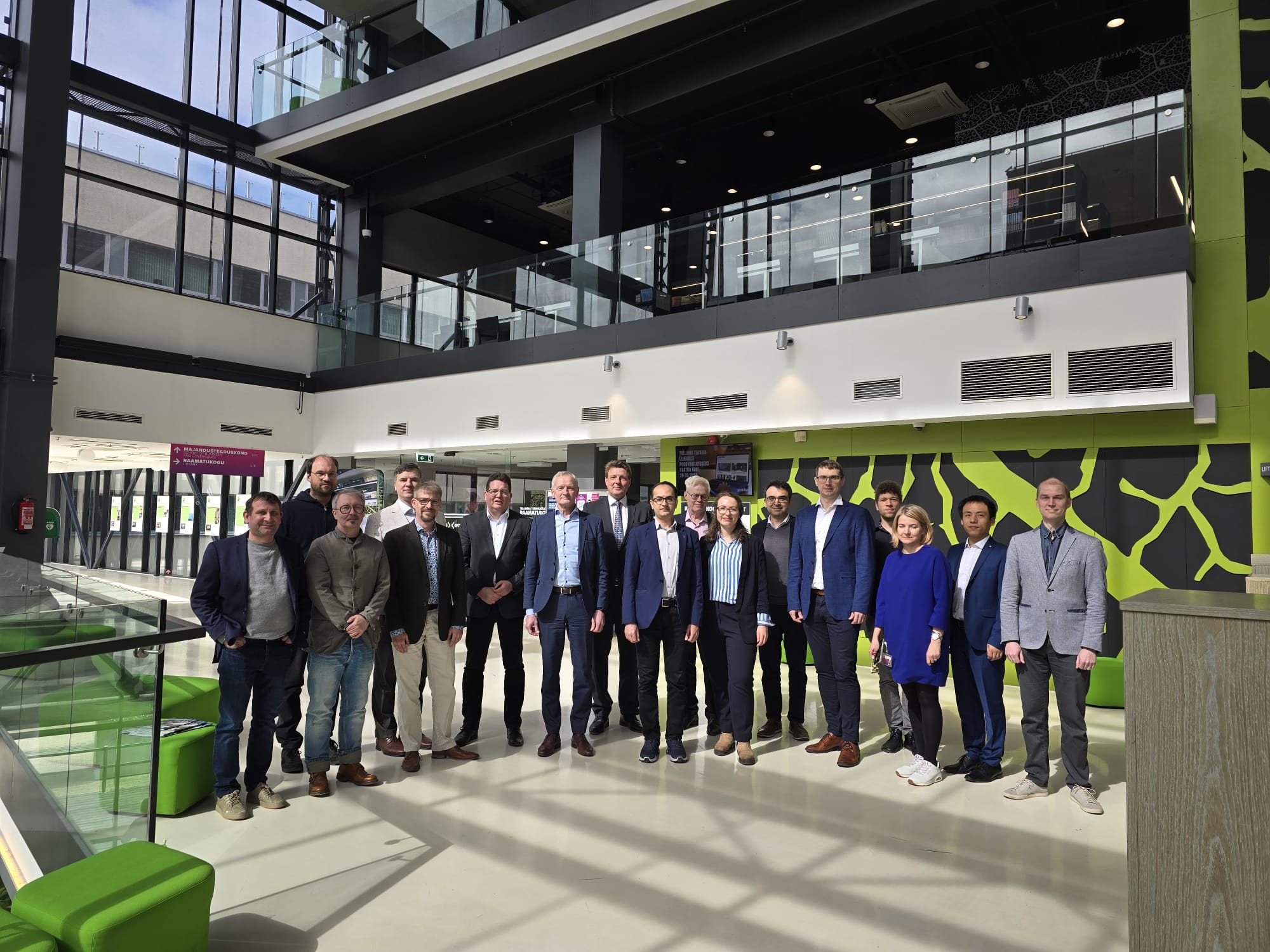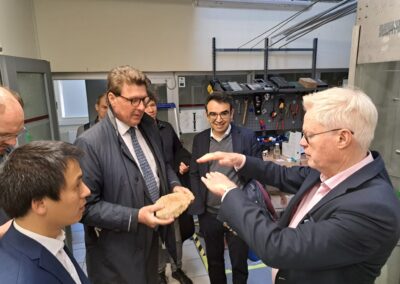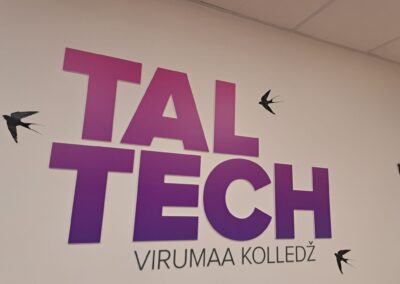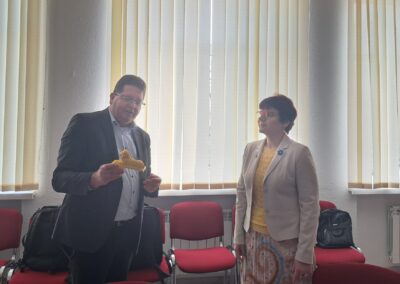Timm Sureau, with Constanze Zwies, Haojie Zhang, Konstantin Branovitskiy and Martin Häuer
A research delegation from the JTC visited Estonian structural change projects and made valuable contacts for longer-term European cooperation. Here they report on their experiences and collaborations.
(Reading time: 9 minutes)

The European Union is facing a reorientation of its structural funding. The previous Just Transition Funds (JTF), which were intended to reduce regional disparities and support regions affected by structural change, are not expected to be extended. Instead, the EU is planning a supra-regional European Competitiveness Fund (ECF) to bundle research, innovation and strategic investments. From April 23 to 24, 2025, scientists from two regions affected by structural change therefore came together to intensify scientific exchange, promote networking, but also to facilitate networking for local projects later on. The scientists from the Central German mining area met with their Estonian colleagues at three locations in Estonia: at the Tallinn University of Technology (TalTech), at TalTech Virumaa College in Kohtla-Järve and at Narva College of the University of Tartu in Narva. This was supplemented by digital presentations by researchers from the University of Tartu.
The organization of the meeting was in the capable hands of Thomas Hoffmann (TalTech and supra-regional), Mare Roosileht (Kohtla-Järve and Narva) and Indrek Reimand (Narva College). Their dedicated work contributed significantly to our understanding of the region and enabled a lively exchange about the work of many scientists, especially during the laboratory visits. This enabled us to lay the foundations for future collaborations.
At all three locations, researchers presented their projects and looked for existing parallels, possible synergies and new opportunities for cooperation. The discussions took place both in specialized break-out sessions, in joint meetings and, of course, in the laboratories we were guided through in Tallinn and Kohtla-Järve.
The meetings were also organized along the local JTC structure, i.e. social sciences and humanities, material sciences and law. The individual results are presented here by each scientist themselves:
continue reading
1.1 Social Sciences
Timm Sureau, Innovation Team A7: The joint meeting (JTC-Halis, TalTech, University of Tartu) made it clear that the two regions of Ida-Virumaa in North-East Estonia and Central Germany are facing similar socio-economic challenges: structural change due to deindustrialization. This makes a stronger focus on services (servitization) – including maintenance, repair and the circular economy – necessary for many companies. Added to this are the effects of demographic change, which can be partially mitigated by labor migration, but at the same time also suffers from the relative unattractiveness of this rural area. The resulting parallels with regard to the identity conflicts associated with change were also striking. Especially when traditional industrial employment is perceived as part of regional identity and many people had hoped to be employed by a large, local industrial employer – regardless of whether this was even a realistic possibility in the recent past. We can definitely learn a lot from our Estonian colleagues in this respect. In order to understand and meet these challenges, it makes sense to strengthen European cooperation across national borders, taking into account regional characteristics and developing joint solutions. Other possible future cooperation partners could be research institutions in the structural change regions in Poland, the Czech Republic, Greece (Western Macedonia) and the non-EU country Great Britain, which appear to be experiencing similar dynamics. The long-term goal is to transfer the knowledge gained from the respective research – for example in relation to servitization, labour migration and the circular economy – into transferable or translatable EU models. The exchange of best practices to promote education and resolve identity conflicts could become a central pillar of this. The researchers also plan to work together to find ways to counteract social fragmentation.
Although we see many opportunities for in-depth collaboration within our research teams, we will still be seeking a precise exchange with the respective teams, most of whom did not participate. We are currently discussing possible collaborations with the University of Tartu. This could open up promising prospects for a practical, European exchange – not least in order to overcome social divisions and shape regional strengthening through innovation and participation.
1.2 Material Sciences
Haojie Zhang of Innovation Team B3: During our recent visit to Estonia, we held in-depth discussions with colleagues from the Estonian JTF project and gained valuable insights into current progress and future plans. This exchange not only strengthened our contacts, but also revealed promising opportunities for joint projects.
We identified the following three key areas for potential collaboration:
- Clean and value-adding processes for oil shale: Estonia has more than 75% of the EU’s oil shale reserves, mainly in Ida-Virumaa in the north-east of the country. Although the oil shale industry there is of great economic importance, it causes considerable CO₂ emissions, which make it more difficult to achieve the EU’s climate targets. The conversion of oil shale into high-quality products is therefore crucial. Our Estonian colleagues in the Industrial Chemistry Laboratory are intensively researching the development of joint processing of oil shale and plastic waste using solid heat transfer technology to produce useful raw materials. Our common goal is to develop electrochemical processes to utilize CO₂ from oil shale processes and produce hydrogen from shale resources.
- Development of efficient electrocatalysts: We were particularly impressed by the DNA-assisted synthesis of chiral structures at TalTech’s Protein Design Lab and the research into metal-organic frameworks (MOFs) at Virumaa College. Both methods open up great potential for highly active electrocatalysts. The aim of our collaboration is to develop effective catalysts for CO₂ reduction and hydrogen production.
- AI-supported design and 3D printing of electrolysis cells: The prototyping lab of our Estonian partners has impressive expertise in metal 3D printing. As the production of complex cell components is often challenging, the combination of AI-supported design and metal 3D printing offers innovative solutions for the development of new types of electrolysis cells.
Constanze Zwies, Innovation Team B4: During our visit to Estonia, two TalTech research groups were of particular interest for our JTC project “Designer proteins as bio-based binders”: the “Wood technology lab”, which is headed by Prof. Jaan Kers, and the “Protein Design lab” headed by Dr. Priit Eek. After a brief presentation of the JTC project at MLU, we were already able to identify a number of opportunities for potential future collaboration.
The team led by Prof. Jaan Kers is dedicated to the production of veneer and veneer wood panels from Estonian woods such as birch, as well as the upgrading of low-grade and underutilized hardwood species such as black alder and aspen. The visit to the production hall for the veneers impressively demonstrated the challenges that arise when processing low-grade woods. The wood industry mainly uses phenol formaldehyde (PF) adhesives to produce veneer panels. The use of these adhesives is problematic as the fossil resources required for their production are finite. In addition, there are health concerns in the production of the glued veneer wood panels and due to the emission of formaldehyde, which is classified as carcinogenic. The EU emission values for formaldehyde in wood-based materials were reduced from 20 mg/m3 to 0.063 mg/m3 in 2023. For this reason, the need for bio-alternatives is of great economic interest. In addition to our ‘Designer Proteins’ project, the group led by Prof Kers and Prof Kallakas is also researching the project ‘Development of Wood-bio-adhesive Systems in Sustainable and Safe Engineered Wood Products in Construction’ (project: PRG2213). The team already has experience with soya protein as a bioadhesive. However, it became clear during the discussion that natural proteins also have some negative properties, such as strong swelling properties.The team led by Prof. Jaan Kers is dedicated to the production of both protein and protein-based products. For this reason, our approach to protein design for optimized binding and adhesion properties of artificial proteins was considered very promising. In the workshop, we developed an idea for a future project design together with Prof. Kers. In addition to the investigation of biobased protein-based binders, this should also include the development of new test standards. Here we also see a collaboration with Team C1 of the JTC, “Standardization and open source”.
Dr Priit Eek’s focus is on the design of novel proteins as additives in the food industry. The project ‘Structural determinants of protein techno-functional properties’ (project: TEM-TA24) aims to develop novel protein additives with improved properties. Although the field of application of these designer proteins differs significantly from ours, we work in a methodologically similar way, as we all use state-of-the-art protein design methods and precise fermentation bioprocesses for the production of the proteins. In further dialogue, we discussed design approaches and possible up-scaling. We see promising prospects for collaboration, particularly in terms of methodology.
1.3 Legal Sciences
Martin Häuer, Innovation Team C1: Our dialogue partners on site showed a keen interest in standards and open source principles, although none of the research groups worked directly on these aspects. Strategic cooperation is particularly suitable with Tarmo Korõtko’s ‘Microgrids on Metrology Research Group’, which develops technical solutions for decentralised energy supply within intelligently and automatically managed low-voltage grids. The aim is to scale electrical energy from solar and wind power, which is naturally subject to strong fluctuations, as widely as possible without overloading the grids. Microgrid hardware and software were originally intended to be developed and published as open source projects, on the one hand to avoid vendor lock-ins for critical infrastructure, and on the other to transfer the technology to an independently viable project with as low a threshold as possible. This could make the microgrid the standard in this niche. On the other hand, there were questions about suitable licence, sustainable business and corporate models, which have so far remained unanswered and thus put the open source approach on ice. We have already been able to provide a lot of input on site and are still in dialogue with the working group.
TalTec’s transfer office expressed interest in open source and open standards as further methods for effective technology transfer, complementary to utilisation through patents. We are in written contact with the transfer centre.
Margit Keller gave a comprehensive insight into the thematically related JTF project from the University of Tartu. The use of open source medical technology to avoid lock-in effects in medical infrastructure could offer an innovative approach in the project (especially for WP5). We are currently discussing the potential for collaboration via e-mail.
Konstantin Branovitskiy, Innovation Team C2: During our visit to Estonia, we were able to identify two key points of contact for scientific collaboration.
On the one hand, a close collaboration with Prof Dr Thomas Hoffmann from TalTec is emerging. Together, we want to analyse questions of global data regulation and access to law in the digital age (meta-standards in law). Our aim is to develop not only dogmatic concepts but also practice-orientated IT solutions, for example in the form of a legal chatbot. The technical expertise of our Estonian colleagues, particularly in dealing with EU-relevant applications, provides an excellent basis for this.
The research group led by Dr Olga Dunajeva (TalTech, Kohtla-Järve), which deals with data mining and human-machine collaboration, will also be a good cooperation partner. We are hoping for interdisciplinary synergies here, especially with regard to our contribution to the LegalTech Lab’s contribution to the JTC colloquium in July 2025 with the topic: ‘New EU Data Regulation – A Practical Guide for Researchers’, in which the Estonian partners would like to actively participate.
2 Extra-University Experiences: On Magnets and Social Cohesion
The visit to the new magnet factory of the Canadian company Neo Performance Materials (NPM), around a quarter of which was financed with JTF funds, was also exciting. Construction began in 2024 and the first samples are currently being built in huge halls so that companies can test the quality of the magnets in their electric motors. The machines for manufacturing the magnets come from China.
We then travelled to Narva. Narva is the third largest city in Estonia and lies directly on the border with Russia and on the other side of the river of the same name lies the Russian city of Ivangorod. In Narva, 98 per cent of the population speaks Russian at home. Around 47 per cent have Estonian citizenship and around 36 per cent have Russian citizenship with a permanent residence permit for Estonia. The inhabitants therefore consume both Russian and Estonian media. In addition, the region is heavily dependent on oil shale mining, which is now slowly being phased out, and is particularly affected by structural change. And the EU sanctions against Russia due to the attack on Ukraine in violation of international law are a living reality here. The day before our arrival, the Estonian Defence Forces announced their decision to establish a military base in Narva. Immediately before our planned meeting, the mayor of the city, Katri Raik, gave an interview about the construction of the military base and then told us about the complexity of her political work in a 90-minute conversation. A lot of dialogue, a lot of public relations work in Russian and Estonian is necessary to keep the city socially together to some extent. During Corona, she told us, the mayor held weekly open press events, which were streamed via Facebook with Estonian and Russian translation.
3 Conclusion: Increased Collaboration
The workshop clearly showed that we in Germany and Estonia are working on very similar problems. Through the exchange in social sciences, materials research and law, we not only identified common problem areas such as social inequality, CO₂ reduction or digital governance, but also discussed concrete cooperation approaches – from bio-based binders to LegalTech solutions.
The visits to Idu Virumaa, Narva and the magnet factory emphasised the practical and political complexities faced by regions undergoing structural change. At the same time, the workshop provided a platform to strengthen networking and drive forward joint projects within the framework of the new European Competitiveness Fund.



